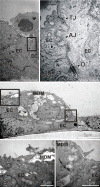Diesel exhaust particles modulate the tight junction protein occludin in lung cells in vitro
- PMID: 19814802
- PMCID: PMC2770470
- DOI: 10.1186/1743-8977-6-26
Diesel exhaust particles modulate the tight junction protein occludin in lung cells in vitro
Abstract
Background: Using an in vitro triple cell co-culture model consisting of human epithelial cells (16HBE14o-), monocyte-derived macrophages and dendritic cells, it was recently demonstrated that macrophages and dendritic cells create a transepithelial network between the epithelial cells to capture antigens without disrupting the epithelial tightness. The expression of the different tight junction proteins in macrophages and dendritic cells, and the formation of tight junction-like structures with epithelial cells has been demonstrated. Immunofluorescent methods combined with laser scanning microscopy and quantitative real-time polymerase chain reaction were used to investigate if exposure to diesel exhaust particles (DEP) (0.5, 5, 50, 125 mug/ml), for 24 h, can modulate the expression of the tight junction mRNA/protein of occludin, in all three cell types.
Results: Only the highest dose of DEP (125 mug/ml) seemed to reduce the occludin mRNA in the cells of the defence system however not in epithelial cells, although the occludin arrangement in the latter cell type was disrupted. The transepithelial electrical resistance was reduced in epithelial cell mono-cultures but not in the triple cell co-cultures, following exposure to high DEP concentration. Cytotoxicity was not found, in either epithelial mono-cultures nor in triple cell co-cultures, after exposure to the different DEP concentrations.
Conclusion: We concluded that high concentrations of DEP (125 mug/ml) can modulate the tight junction occludin mRNA in the cells of the defence system and that those cells play an important role maintaining the epithelial integrity following exposure to particulate antigens in lung cells.
Figures








Similar articles
-
Diesel exhaust particle exposure reduces expression of the epithelial tight junction protein Tricellulin.Part Fibre Toxicol. 2020 Oct 15;17(1):52. doi: 10.1186/s12989-020-00383-x. Part Fibre Toxicol. 2020. PMID: 33059747 Free PMC article.
-
Effect of lipopolysaccharide on diesel exhaust particle-induced junctional dysfunction in primary human nasal epithelial cells.Environ Pollut. 2019 May;248:736-742. doi: 10.1016/j.envpol.2019.02.082. Epub 2019 Feb 26. Environ Pollut. 2019. PMID: 30849591
-
Density-enhanced phosphatase 1 regulates phosphorylation of tight junction proteins and enhances barrier function of epithelial cells.J Biol Chem. 2009 May 29;284(22):14997-5006. doi: 10.1074/jbc.M901901200. Epub 2009 Mar 30. J Biol Chem. 2009. PMID: 19332538 Free PMC article.
-
The dual effect of the particulate and organic components of diesel exhaust particles on the alteration of pulmonary immune/inflammatory responses and metabolic enzymes.J Environ Sci Health C Environ Carcinog Ecotoxicol Rev. 2002 Nov;20(2):117-47. doi: 10.1081/GNC-120016202. J Environ Sci Health C Environ Carcinog Ecotoxicol Rev. 2002. PMID: 12515672 Review.
-
Causation by Diesel Exhaust Particles of Endothelial Dysfunctions in Cytotoxicity, Pro-inflammation, Permeability, and Apoptosis Induced by ROS Generation.Cardiovasc Toxicol. 2017 Oct;17(4):384-392. doi: 10.1007/s12012-016-9364-0. Cardiovasc Toxicol. 2017. PMID: 26965709 Review.
Cited by
-
Exploring the immunopathology of type 2 inflammatory airway diseases.Front Immunol. 2024 Apr 12;15:1285598. doi: 10.3389/fimmu.2024.1285598. eCollection 2024. Front Immunol. 2024. PMID: 38680486 Free PMC article. Review.
-
Effects of Particulate Matter in a Mouse Model of Oxazolone-Induced Atopic Dermatitis.Ann Dermatol. 2020 Dec;32(6):496-507. doi: 10.5021/ad.2020.32.6.496. Epub 2020 Nov 11. Ann Dermatol. 2020. PMID: 33911793 Free PMC article.
-
Epithelial cells, the "switchboard" of respiratory immune defense responses: effects of air pollutants.Swiss Med Wkly. 2012 Jul 31;142:w13653. doi: 10.4414/smw.2012.13653. eCollection 2012. Swiss Med Wkly. 2012. PMID: 22851042 Free PMC article. Review.
-
Assessment of an in vitro model of pulmonary barrier to study the translocation of nanoparticles.Toxicol Rep. 2014 May 12;1:157-171. doi: 10.1016/j.toxrep.2014.03.003. eCollection 2014. Toxicol Rep. 2014. PMID: 28962236 Free PMC article.
-
Short-term exposure of PM2.5 and PM10 increases the number of outpatients with eczema in Guangzhou: A time-series study.Front Public Health. 2023 Feb 21;10:930545. doi: 10.3389/fpubh.2022.930545. eCollection 2022. Front Public Health. 2023. PMID: 36895444 Free PMC article.
References
-
- Pope CA, III, Thun MJ, Namboodiri MM, Dockery DW, Evans JS, Speizer FE, et al. Particulate air pollution as a predictor of mortality in a prospective study of U.S. adults. Am J Respir Crit Care Med. 1995;151:669–674. - PubMed
-
- Peters A, Wichmann HE, Tuch T, Heinrich J, Heyder J. Respiratory effects are associated with the number of ultrafine particles. Am J Respir Crit Care Med. 1997;155:1376–1383. - PubMed
-
- Bayram H, Devalia JL, Sapsford RJ, Ohtoshi T, Miyabara Y, Sagai M, et al. The effect of diesel exhaust particles on cell function and release of inflammatory mediators from human bronchial epithelial cells in vitro. Am J Respir Cell Mol Biol. 1998;18:441–448. - PubMed

